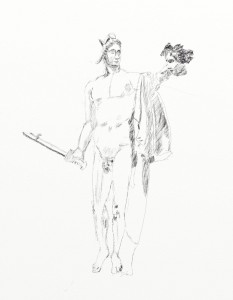This OT excursion is only a temporary loss of focus. In search of a place to run this piece, motivated by personal experience, I thought, why not my own blog? It affords the opportunity to compare the time-honed methods of traditional fortune tellers with the methods of those who currently pursue future knowledge. The techniques of divination may overlap.
The Post-Internet Fortune Teller in Chelsea
Ofri Cnaani, post-internet artist and instructor at the School of Visual Arts, SVA, has a show at Andrea Meislin Gallery, 534 W 24th St., Chelsea, running through October 24. Ofri has used the cyanotype process, known to us as “blueprint”, to create spaces that, if not dreamscapes, inhabit the same places as dreams. Several other composite works turn computer frustration into art. I am somewhat disappointed with the omission of the infamous Microsoft “Blue Screen of Death.” This computer equivalent of cyanide would have been well served by cyanotype. On the other hand, anyone who has actually experienced the Blue Screen of Death might prefer to forget it. Ofri is a Mac user.
If you would relish the chance to stare directly into Ofri’s eyes, go to the show. It’s part of the “process”, a performance event called, “Wrong Tools”, in which Ofri plays the post internet transmogrification of the Gypsy fortune teller. Gone are the beads and curtains, replaced by discarded computer chachkis. The tarot deck is replaced by one depicting and betraying those who have fallen to the cruel logic of the Internet. One personal possession and two chosen by the participant from bins of cast-offs are melded by Ofri into your personal reading and personal work of art. But two traditions remain: the card flip, and locking eyes with the Internet Spirit, channeled, in this case, by Ofri.
My card was flipped. I wailed in sorrow as it betrayed my fate: “Your posts are being used against you.” Ofri interrupted my lament, commanding me to stare directly into her eyes, “for the process.” Our not-quite-blazing eyes locked for the prescribed interval, during which I was completely unconscious of what happened, if anything. A whir of a photocopier, and my personal work of art was handed to me, sharply downscaled in beauty from the cyanotypes, but a keeper nonetheless.
“Wrong Tools” was a reminder of my own gypsy adventures. I wrote a script about gypsies. It actually got optioned, though nothing came of it. I was diligent. I joined the Gypsy Lore Society. I read such sociological literature as exists from the intense curiosity of sociologists of this apparently insoluble underclass. And with the insane synchronicity in my life, I had a Gypsy quasi-girlfriend (she wanted to hook me, but I didn’t want to be hooked.) Her mom was actually super nice. She had been Jimi Hendrix’s last girlfriend, inspiration for his song, “Gypsy Eyes.”
The Gypsies (more correctly, “Rom”) of her class were nothing like the stereotypical gypsies, who also exist. In Atlantic City, scouting locations for the film, I landed directly on top, parking-wise, of the last remaining ofisa on the Atlantic City Boardwalk. The ofisa had traditional elegance, reprising the temporary, transportable opulence of a nomad’s lifestyle. The human adornment was an obviously very intelligent and not unattractive young woman and her grandmother. The young woman had all the material to be a lawyer, but was condemned to be married off. How was this to be accomplished? By family arrangement, or by way of her performance art? The question lingers.
In manner and appearance, there was an Sephardic resemblance. Nothing else distinguished her, except for obvious intelligence, and the weight of her gown, which caused her to sweat. By watching the rate of bead formation on her forehead, I had an instantaneous readout of her stress level. Never before, perhaps, was she studied as closely as I was to study her, as, simultaneously, she tried to divine me. Sweat, as every interrogator knows, is gold.
I was accompanied by the cinematographer. To get the most out of it, I forked over the twenty bucks for a reading. I was conducted to a tiny back booth, where she tried to script ninety seconds that would not compromise her reputation, so dearly supported by her gown, the rugs, the beads, the spiritual figures and figurines, and several hundred pounds of chachkis.
She actually did pretty well. I think she might have “divined” three things, two of which I remember:
- Money comes to me easily and leaves me easily. Sure. I had just dropped a twenty on her. Easy come, easy go.
- I have woman troubles. A man comes in with another man. Where is the woman? Play the averages. Ergo, the man has woman troubles.
The ninety seconds exhausted her. Swaddled in the fabric yards of tradition, her glow was replaced by sweat. I cannot imagine how she survived the rest of the day without a change of clothes, into something more appropriate, like a bathing suit.
Perhaps I forget the other things she told me because they were a potpourri of things that are true and false for everybody. For another twenty bucks, I could have had another ninety seconds of her script. But alas for her divination of my traits, easy come easy go has limits. I have my regrets also, but it wasn’t about the twenty bucks. I would have liked to know her better, but I shied from the risk and the pain.
Are Ofri’s “Wrong Tools” the wrong tools for the job? Conduct yourself to Andrea Meislin, compare to my Gypsy experience, and then decide.
